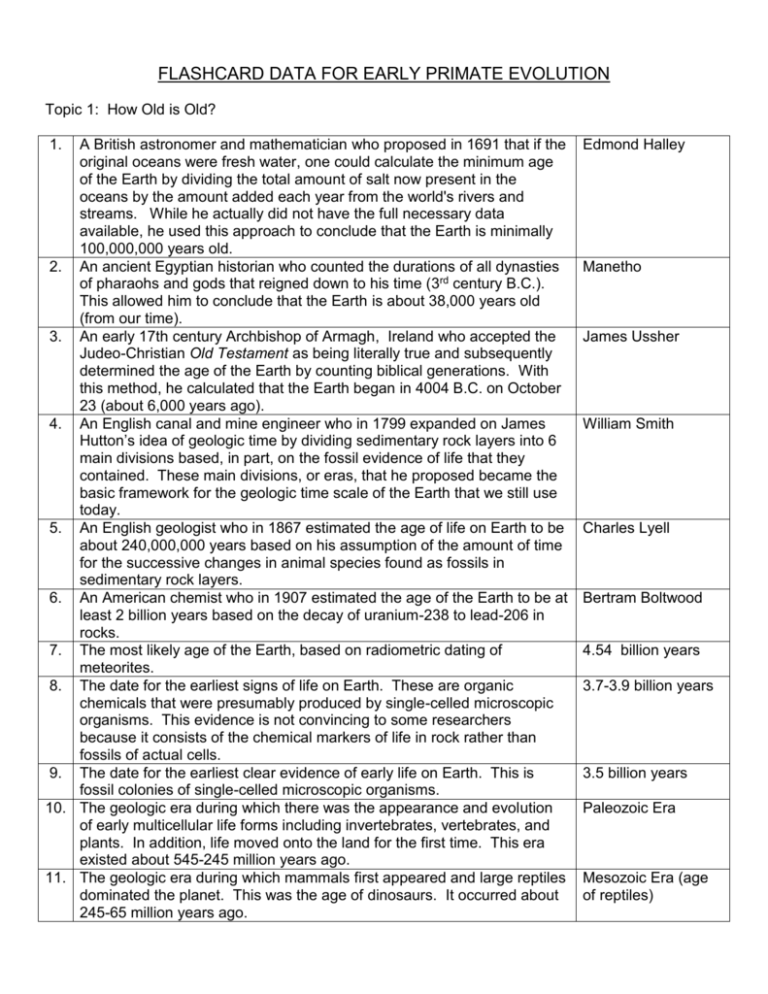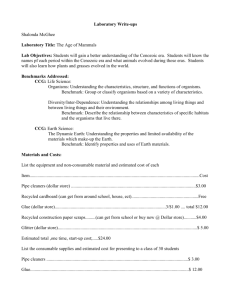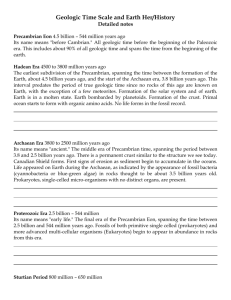
FLASHCARD DATA FOR EARLY PRIMATE EVOLUTION
Topic 1: How Old is Old?
1.
A British astronomer and mathematician who proposed in 1691 that if the
original oceans were fresh water, one could calculate the minimum age
of the Earth by dividing the total amount of salt now present in the
oceans by the amount added each year from the world's rivers and
streams. While he actually did not have the full necessary data
available, he used this approach to conclude that the Earth is minimally
100,000,000 years old.
2. An ancient Egyptian historian who counted the durations of all dynasties
of pharaohs and gods that reigned down to his time (3rd century B.C.).
This allowed him to conclude that the Earth is about 38,000 years old
(from our time).
3. An early 17th century Archbishop of Armagh, Ireland who accepted the
Judeo-Christian Old Testament as being literally true and subsequently
determined the age of the Earth by counting biblical generations. With
this method, he calculated that the Earth began in 4004 B.C. on October
23 (about 6,000 years ago).
4. An English canal and mine engineer who in 1799 expanded on James
Hutton’s idea of geologic time by dividing sedimentary rock layers into 6
main divisions based, in part, on the fossil evidence of life that they
contained. These main divisions, or eras, that he proposed became the
basic framework for the geologic time scale of the Earth that we still use
today.
5. An English geologist who in 1867 estimated the age of life on Earth to be
about 240,000,000 years based on his assumption of the amount of time
for the successive changes in animal species found as fossils in
sedimentary rock layers.
6. An American chemist who in 1907 estimated the age of the Earth to be at
least 2 billion years based on the decay of uranium-238 to lead-206 in
rocks.
7. The most likely age of the Earth, based on radiometric dating of
meteorites.
8. The date for the earliest signs of life on Earth. These are organic
chemicals that were presumably produced by single-celled microscopic
organisms. This evidence is not convincing to some researchers
because it consists of the chemical markers of life in rock rather than
fossils of actual cells.
9. The date for the earliest clear evidence of early life on Earth. This is
fossil colonies of single-celled microscopic organisms.
10. The geologic era during which there was the appearance and evolution
of early multicellular life forms including invertebrates, vertebrates, and
plants. In addition, life moved onto the land for the first time. This era
existed about 545-245 million years ago.
11. The geologic era during which mammals first appeared and large reptiles
dominated the planet. This was the age of dinosaurs. It occurred about
245-65 million years ago.
Edmond Halley
Manetho
James Ussher
William Smith
Charles Lyell
Bertram Boltwood
4.54 billion years
3.7-3.9 billion years
3.5 billion years
Paleozoic Era
Mesozoic Era (age
of reptiles)
12. The geologic era following the extinction of the last dinosaurs. During
this era, more advanced mammals (placental mammals) rapidly evolved
and became the dominant large animals. It was only in this last geologic
era that primates evolved.
13. The number of known major global extinction events that have occurred
on Earth.
14. The Earth's outer rock shell consisting of about a dozen enormous rigid
tectonic plates and many smaller ones that are more or less constantly
moving relative to each other at a rate of a few centimeters a year.
15. The super-continent that was created when all of the continents came
together and fused early in the time of the dinosaurs. It began forming
about 285 million years ago. It was complete by about 210 million years
ago and began drifting apart again 10 million years later. The name of
this super-continent literally means "all of the Earth" in Greek.
Cenozoic (age of
mammals)
six (they occurred
about 488,440, 360,
251, 200, and 65.5
million years ago)
lithosphere
Pangaea
Topic 2: The First Primates
1.
2.
3.
4.
5.
6.
7.
Another name used to describe the first primate-like mammals that were
evolving by the beginning of the Cenozoic Era 65 million years ago.
They were roughly similar to squirrels and tree shrews in size and
appearance. The existing, very fragmentary fossil evidence suggests
that they were adapted to an arboreal way of life in warm, moist climates.
Latin terms used to refer to the plants and animals in an environment.
The biological order of mammals that was named for their adaptation to
eating insects. They were among the earliest of the placental mammals
to evolve. They first appeared before the end of the Mesozoic Era.
The relatively rapid expansion and diversification of an evolving group of
organisms as they adapt to new ecological niches. This is the process
by which one species evolves into two or more species. This occurs as a
result of different populations becoming reproductively isolated from each
other, usually by adapting to different environments.
The geologic epoch that occurred about 55-34 million years ago. It was
during this epoch that early forms of most of the placental mammal
orders that are present today first appeared. Among them were primate
species that somewhat resemble modern prosimians such as lemurs,
lorises, and possibly tarsiers. This was the epoch of maximum prosimian
adaptive radiation.
The term for the hole at the base of a skull through which the spinal cord
passes. It literally means a "large hole or opening" in Latin.
The 1200 mile long depression or valley system running northeast to
southwest in East Africa. This valley system with lakes and grasslands
developed in a volcanically active fault zone at the juncture of two large
tectonic plates.
proto-primates
flora and fauna
Insectivora or
Insectivore
adaptive radiation
Eocene Epoch
foramen magnum
Great Rift Valley
system
8.
The geological epoch that occurred about 34-23 million years ago. It was
in this epoch that the first monkeys evolved from prosimians. By the
beginning of this epoch, North America and Europe drifted apart and
became distinct continents. The Great Rift Valley system of East Africa
also was formed. The Himalayan chain of mountains and the Tibetan
Plateau beyond rose high as the Indian tectonic plate continued to crash
into Asia. This epoch follows the Eocene Epoch.
9. The general term for a seasonally dry tropical or subtropical grassy plains
with scattered trees. These environments are usually the habitat of large
herbivores and their predators. The first hominids apparently evolved on
and near East and South African areas like this.
10. The geological epoch that occurred about 23-5 million years ago. It was
during this epoch that apes evolved from monkeys. Fossil monkeys and
prosimians are comparatively rare from most this epoch, but apes are
common. By 14 million years ago, the group of apes that included the
ancestors of humans were apparently in the process of adapting to life on
the edges of the expanding savannas in Southern Europe.
11. The term for a four-footed form of locomotion. This is characteristic of
most mammals. Humans are exceptions, being bipeds.
Copyright © 2005-2007 by Dennis O'Neil. All rights reserved.
Oligocene Epoch
savanna
Miocene Epoch
quadrupedal
(quadruped)












